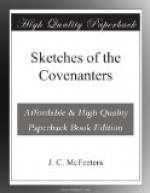[Illustration: Signing the covenant.
The Covenant of 1638 was signed first by those who filled the Greyfriars’ Church. The parchment was then brought outside and laid on a flat tombstone, where those who had assembled in the churchyard eagerly embraced the opportunity to add their signatures. The people were deeply moved, as they thus joined themselves and their children to the Lord, in an everlasting Covenant never to be forgotten.]
At the appointed hour, Greyfriars’ Church and churchyard were crowded “with Scotland’s gravest, wisest, and best sons and daughters.” Alexander Henderson constituted the meeting with prayer. His earnest words were deeply felt, they seemed to bring the Lord of glory out of heaven. The Earl of Loudon made a solemn address, appealing to the Searcher of motives. Archibald Johnston unrolled the vast parchment and read the Covenant in a clear voice. Silence followed—a dreadful pause during which the Holy Spirit was doing great work on all present. The Earl of Rothes broke the silence with a few well-chosen words. Another solemn pause ensued, while all eyes watched for the next act in the sublime programme. The Covenant was ready for signatures. What name will have the honor of heading the list on that white parchment? At length the Earl of Sutherland, an aged elder, with much reverence and emotion, stepped forward and taking the pen with trembling hand subscribed his name. Others rapidly followed. The heart went with the name, the blood was pledged with the ink, the Covenant was for life even unto death. When all in the church had subscribed, the parchment was carried to the churchyard and placed on a flat tombstone, where the people outside added name after name till there was no room, no, not for an initial letter. The scene was impressive beyond description; the people gave themselves willingly unto the Lord. Many wrote through blinding tears and with throbbing hearts; some added the words, “Till death”; some drew blood from their own veins for ink. Then as the sun was westering in the cold sky, they lifted up the right hand to Almighty God, the Searcher of hearts, avowing allegiance to Him with the solemnity of a most sacred oath. Surely this was Scotland’s greatest day. The Church may now be called Hephzibah, and her land, Beulah. Immanuel is the name of her Covenant Lord. “Glory, glory, in Immanuel’s land!”
The evening drew on; the spirited demonstrations of that eventful day, like a glorious sunset, melted away; but the Covenant, in all its sacredness, substance, obligations, and strength, remained for the next day, and the next generation, and all generations to come. Thus was Scotland’s National Covenant renewed in 1638.




